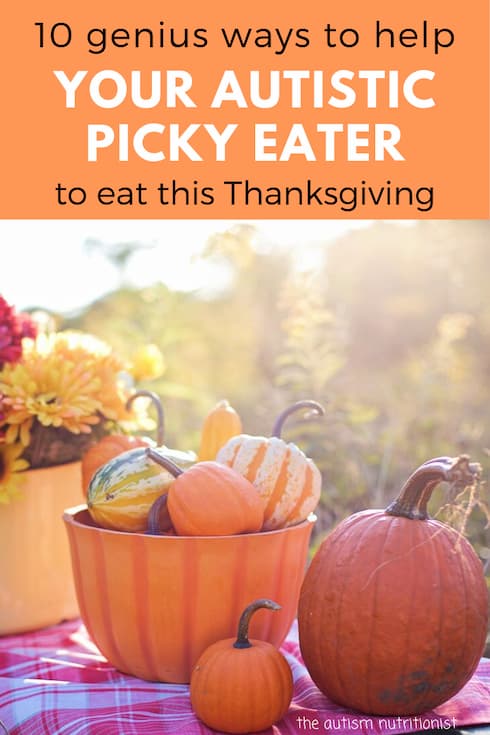
Thanksgiving — a holiday defined by food — can be extra challenging for picky eaters and extra extra challenging for picky eaters on the autism spectrum.
The combination of a deviation from routine and a day filled with unusual foods, smells, and often people can easily add stress to what is meant to be a festive, special day.
Thanksgiving and Autism
With some preparation and slight adaptations you can still enjoy the holiday with your picky eater.
Try these tips to make Thanksgiving more comfortable for your child with autism without sacrificing nutrition or tradition.
How to Enjoy a Healthy and Happy Thanksgiving with Your Autistic Picky Eater
Serve at least one food you know your child eats
No matter where the Thanksgiving meal is served this year, include at least one of your child’s favorite foods. This makes the meal feel safer and more inviting to your child. It also takes some of the stress away from you because you know that your child will eat at least one thing.
A mom in my community shared with me that she lets her son make a dish to take with them to dinner. That way he not only has one thing he will definitely eat, but also gets excited seeing his contribution among the rest of the meal.
Be lenient with tradition
Without taking away from any traditional foods or activities, think about adding in everyday comforts that will make the day easier for your child. Whether this is serving his preferred crackers, letting your child eat on his own, or starting the meal with some heavy work activities, embrace the adaptations that will allow your child to participate more comfortably.
Prepare guests
Everyone has expectations for holidays. Whether you’re visiting friends or family or hosting the meal, let your hosts or guests know ahead of time about your child’s eating needs and how you’re working to make her more comfortable.
Share meal planning with your child
Ask your child to help with some of the Thanksgiving menu decisions. Pose simple questions like: “Would you prefer sweet potatoes mashed or roasted?” Together find recipes. A child who helps with menu and meal preparation is more likely to actually eat.
Invite your child to cook
Invite your child to help prepare the Thanksgiving meal. Toddlers can clear or chop vegetables. Older kids can use the stove with supervision. When kids help cook food, they often sample what they are preparing, and are more likely to eat later.
Make food connections
Many Thanksgiving dishes might be new to your child. Find similar properties that link these new foods to your child’s favorites. Show that the mashed potatoes are smooth and creamy like her favorite smoothie or that the stuffing has cinnamon just like the applesauce she eats.
These connections will make the unfamiliar foods seem more comfortable and will help your child anticipate what the new eating experience will be like. Both increase the likelihood of your child trying and enjoying a new food.
Keep the mealtime comfortable
When it comes to feeding, your job as a parent is to provide a meal that your child can eat. This includes making adaptations to the eating environment and/or providing your child with tools to make the meal more comfortable. This might include seating your child at the end of the table away from your aunt who chews loudly or making sure his chair is supportive. It might also mean bringing along the preferred plate or a tablet to use at the table.
Do what you can to support your child and if he doesn’t eat as much or as varied a plate as you’d like, know that you did what you could.
Consider alternatives
Sitting with a large group, encountering different food, and being in an unusual place might be more than your child can handle. That’s okay. Make whatever adjustments are necessary to help everyone have a comfortable and enjoyable day. Maybe this means your child eats his preferred foods or eats away from the group.
Think outside the box and don’t be afraid to be a little less traditional. Do what you need to do so that you and your picky eater can both enjoy the holiday.
Stick to routines
Keep things as familiar as possible. If you follow any mealtime routines (like washing hands before the meal), stick to these. Serve the meal at the same time. Try to eat in the same place using the same plates and serving spoons. If you normally light candles, light them. If you don’t, maybe skip them this year.
Veering from routine can make your child anxious. Anxiety suppresses the appetite which further reduces the chances that your child will eat.
Know that you did enough
If you’re anything like parents in my coaching program, you’re working extremely hard every day to help your child have an easier time eating. Thanksgiving is just one day – but it’s also an unusual day. Know that you what you could to prepare.
Recap
Thanksgiving – a day with different foods, different smells, a different routine, different people, and a lot of pressure to have fun – can be a rough day for kids with autism and especially kids with autism who are picky eaters. With some modifications and planning, you can still have a wonderful holiday that your child enjoys and a holiday meal that your child actually eats.
Homework
Start planning Thanksgiving a little early this year so you can begin to make the above adaptations to increase the likelihood that your child eats and enjoys the holiday. Focus on the tips that are most relevant to your family and make a plan how you can make them work for you.



0 Comments